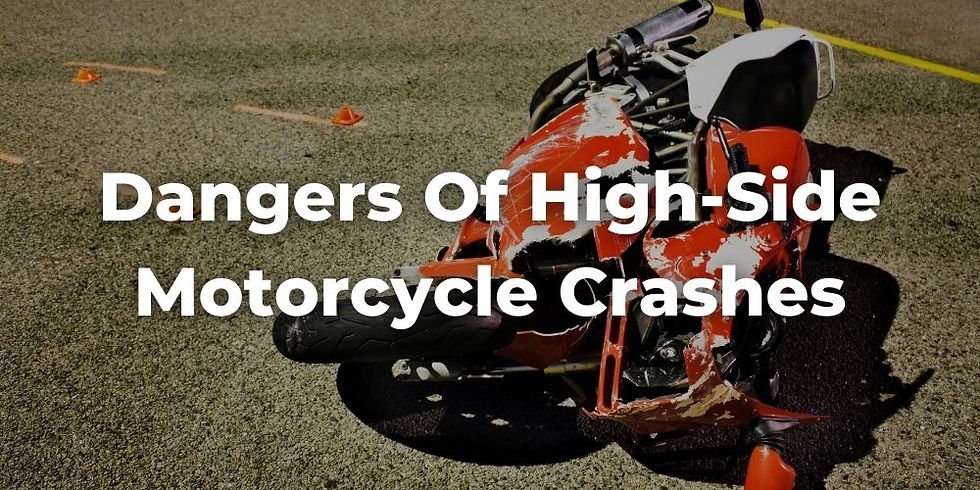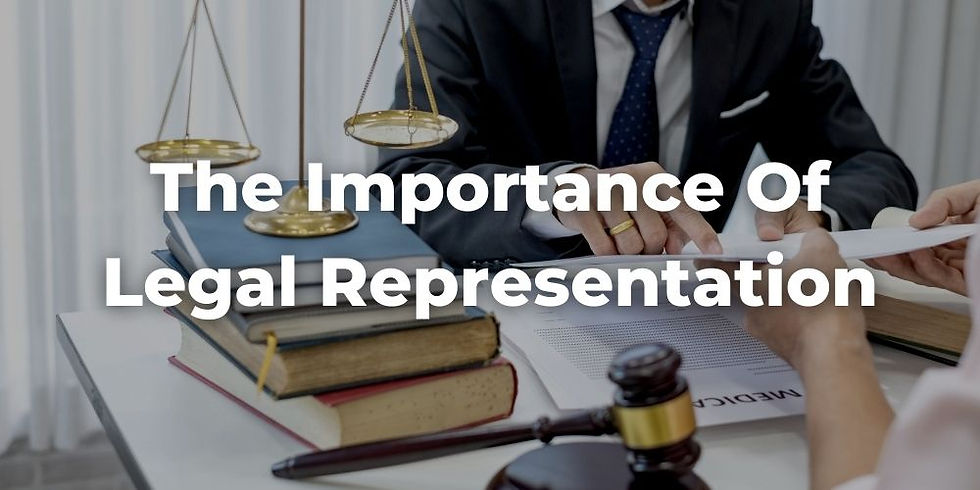An In-depth Analysis: What Causes a High-side Motorcycle Crash?
- Robert Schuerger II

- Jul 31, 2023
- 6 min read
In the thrilling world of motorcycle riding, the rush can sometimes be tainted by the risk of accidents. One of the most prevalent yet harrowing scenarios involves high-side motorcycle crashes. This incident begins when the rear wheel loses traction, often due to too much speed or acceleration.
Furthermore, the motorcycle's rear tire can lose its lateral grip by navigating a curve at high speed. The subsequent attempt to regain traction and an unstable front wheel can throw the rider off, leading to a high-side crash.
Moreover, this phenomenon isn't just restricted to novice riders. Even experienced ones aren't immune, demonstrating the precarious nature of such accidents.
In this article, readers will gain a deeper understanding of the factors contributing to high-side motorcycle accidents and how these differ from lowside crashes.
By comprehending the mechanics and causes behind these unfortunate events, individuals can better equip themselves with knowledge and prevention strategies, reducing their risk on the road.

The Dangers of High-side Motorcycle Crashes
In the history of motorcycle incidents, the high-side crash earns its reputation as an unsettling and dangerous event. These accidents can occur when a rider pushes the speed and acceleration limits, causing the rear tire to lose traction. Schuerger Shunnarah Trial Attorneys can help advise on questions such as, "What is the survival rate for motorcycle crashes?"
This momentary loss of control triggers a scenario where the motorcycle's rear wheel begins to move wildly, sliding sideways and potentially leading to disaster.
What sets the high-side incident apart from its less severe counterpart, the low-side motorcycle crash, is its abrupt and often brutal ending.
Moreover, in its struggle to regain grip, the motorcycle can jerk violently sideways, causing a phenomenon known as "tank slapping." This seesawing motion can fling the rider of the vehicle, usually over the handlebars, a trajectory that can result in serious injuries.
These incidents can happen even at relatively slower speeds, making them a concern not just for speed enthusiasts but for all motorcycle riders.
Drivers can also experience a high-side motorcycle accident caused by external factors, such as oil or sand, on the road that interferes with the tire's grip. The sudden loss of traction can start the wobble, further magnified if the rider instinctively tightens their grip on the handlebars.
Awareness of the risks involved in motorcycle riding can help riders develop better strategies to stay safe on the road. It emphasizes the importance of maintaining appropriate speeds and practicing controlled handling techniques.
What Causes a High-side Motorcycle Crash?
A high-side motorcycle crash doesn't happen randomly but is often the culmination of multiple contributing factors.
The main culprit is usually when the rear tire loses traction and then abruptly regains it, catapulting the rider off the motorcycle in a phenomenon known as a highside crash.
However, what scenarios set the stage for the rear wheel to lose traction in the first place? Here are some cases:
Dangerous Road Conditions
Road surfaces fraught with oil, water, or ice make for slippery paths that may cause the rear wheel to lose control. Should the tire regain traction mid-skid, the rider risks being ejected into the air, transforming a simple ride into a dangerous highside crash.
Too Much Acceleration
The danger can also lie in too much acceleration, especially when emerging from a lean-heavy turn. Additionally, the tire, grappling with the increased speed while still on its edge, could lose control, hence causing a crash.
Impulsive Downshifting
In a rush to downshift before entering a turn, the rear wheel can lock up, leading to a loss of traction and a potential highside crash. Moreover, the wheel regaining traction here could mean the rider being thrown off the motorcycle.
Excessive Lean into a Curve
Leaning too far into a curve can also result in a high-side accident. The rear tire loses traction when the bike comes into contact with the ground due to pressure from the muffler, footpeg, or even the rider's foot.
While the unpredictability of a highside crash might be alarming, understanding its triggers can empower riders to drive with increased vigilance and caution, potentially avoiding a serious motorcycle accident.
Riders should strive to maintain a balance between speed and control, especially during turns or on dangerous roads, and to ensure their motorcycles are in optimal condition to handle such stresses.
Understanding Low-side Motorcycle Accidents
Motorbike incidents can take various forms, but low-side motorcycle accidents are among the most common. They occur when the motorcycle leans into a turn, and the bike levels on the same side as the lean.
There are two main types: front-wheel and rear-wheel low-side crashes. The distinction lies in which wheel loses grip first.
In the first scenario, the front wheel loses traction while the motorcycle turns, resulting in a slide. On the other hand, in the second scenario, the slide is triggered by the rear wheel's loss of grip.
Possible Causes of Low Side Motorcycle Crashes
Low-side crashes can occur due to various conditions, including:
Excessive braking: Over-braking when entering a turn can lead to a low-side collision.
Old tires: Worn-out tires often lack the necessary traction, causing the bike to slide during a turn.
High speeds: An early acceleration through a turn before the bike is out of the lean can result in a lowside crash.
Poor road conditions: Hazards such as gravel, oil, or ice can cause the bike to lose traction and slide during a turn.
Approaching turns at high speeds: A lowside crash may occur if a motorcyclist leans beyond the bike's capacity while turning.
Additionally, overreliance on the rear brake during sharp turns can precipitate a low-side crash. Applying too much throttle when exiting a turn can destabilize the motorcycle, increasing the risk of an accident.
Understanding the complexities of motorcycle operations, particularly in turns, is crucial in preventing low-side crashes. Being aware of road conditions and practicing safe riding techniques can make a difference in avoiding serious injuries.
Potential Injuries from a Motorcycle Accident
Consequently, the aftermath of a motorcycle accident, whether it's a low-side or high-side crash, often paints a grim picture. The injuries sustained can impact any part of the body and vary in severity based on the circumstances of the accident.
Moreover, the potential risks are broad, with some more common than others:
Head trauma: From concussions to traumatic brain injuries, the head is particularly vulnerable during a motorcycle accident. Notably, not wearing a helmet increases the risk.
Spinal injuries: Damage to the spinal cord can occur, leading to life-changing consequences such as paralysis or chronic pain.
Road rash: This term refers to skin and tissue damage resulting from the body sliding across the pavement, a common occurrence in motorcycle accidents.
Cuts and bruises: Drivers can sustain various scrapes, bruises, and bumps from the impact or debris during a crash.
Burns: These may result from contact with hot motorcycle parts or even from the friction of sliding on a surface.
Facial damage: Trauma to the face or eyes can be particularly devastating, potentially resulting in loss of sight or disfigurement.
Bone fractures: The force of a crash can easily lead to broken bones, especially in the arms and legs.
Internal injuries: Damage to internal organs or internal bleeding might not be immediately visible but can be life-threatening.
Limb loss: In severe cases, a crash can result in the loss of a limb.
It's worth noting that some injuries might not manifest immediately and could surface hours or even days after the accident.
Therefore, it's important to seek medical attention promptly after a motorcycle accident, even if the injuries initially seem minor.
By understanding the common types of injuries, riders can better comprehend the risks and importance of safety measures when hitting the open road.

The Importance of Legal Representation After a Motorcycle Accident
Following a motorcycle accident, be it a high-side or a lowside crash, an experienced motorcycle accident attorney is crucial.
Dealing with the aftermath of an accident involves more than just managing physical injuries. Victims also grapple with insurance claims, possible legal issues, and potential loss of income.
The best motorcycle accident lawyer in Nashville understands the nuances of such cases, whether it involves a front-wheel incident, a lowside crash, or a situation with too much speed or throttle involved.
An attorney can ensure victims receive the compensation they deserve, covering medical bills, property damage, and other related costs.
Furthermore, legal representation is critical in navigating complex litigation processes in cases involving serious injuries. The aftermath of a motorcycle accident can be overwhelming, and having a motorcycle accident lawyer at your side eases the burden significantly.
Legal expertise is paramount to safeguard the rights of accident victims. Moreover, for those in Nashville, Tennessee, Schuerger Shunnarah Trial Attorneys are ready to go to war for clients, providing them with the expert representation they deserve. Hence, victims should not hesitate to reach out today for professional assistance. They can help with questions like, "Is it illegal to drive barefoot in Tennessee?"
Final Thoughts
The dynamics of motorcycle accidents, especially low-side and high-side crashes, represent a critical aspect of road safety. Causes such as too much speed, acceleration, a slide of the rear wheel, or incorrect counter-steer maneuvers can lead to serious incidents and significant injuries.
However, the key to preventing these crashes is understanding their origins and practicing safe riding techniques. When accidents do occur, legal assistance becomes essential.
Navigating the aftermath of motorcycle accidents, particularly high-side and lowside crashes, requires expert knowledge. In Nashville, Tennessee, Schuerger Shunnarah Trial Attorneys stand ready to provide guidance and representation to victims in their quest for justice.
